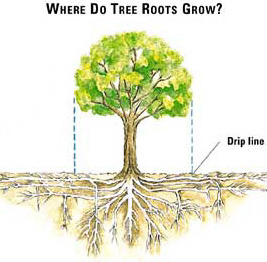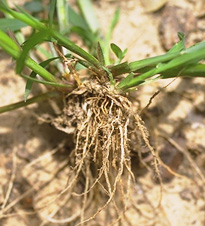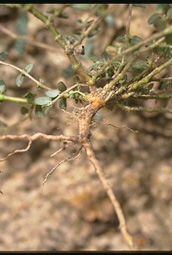|

|
A large
proportion of a mature tree's roots are in the top metre of
soil, where they have access to oxygen, water, and
nutrients. In their search for these essentials of
life, the roots may extend horizontally well beyond the drip
line at the edge of the tree's canopy. (The drip line is
where water would drip of the outermost leaves on the
tree.)
Though hidden below ground and
often ignored by gardeners, roots are vital to a plant's
survival and growth. They absorb water and nutrients and
help move them throughout the plant; they store food for
future use; and they anchor the plant in the soil.
(Nutrients are the chemicals that plants need to use as
food).
|
|
|
As they go looking for water and nutrients, roots grow through the
soil away from the center of the plant. This growth takes place in
the root tip where cells are actively dividing and elongating. Just
behind the tender root tip, which is protected by the root cap, is a
zone of cells that produce many tiny projecting root hairs. These are
in direct contact with the soil and increase the surface area
available for absorption of water and nutrients. Have a look at the
microscopy site to see some hugely enlarged pictures of roots and
root hairs!
If they are exposed to sunshine or dry air,
the root hairs quickly shrivel and die. When plants are dug up by
people or animals, they will quickly wither and die.
Plants are anchored in the soil by fibrous
roots, taproots, or (sometimes) a combination of both. A fibrous root
system has many branching roots that grow fairly close to the soil
surface. The taproots of some large trees and shrubs, in contrast,
grow deep into the soil and develop horizontal branches that hold the
plant firmly in place.
 . . . . . . . . . . . .
. . . ..
. . . . . . . . . . . .
. . . .. 
(A fibrous root system to the left, and a tap root to the
right)
Adventitious Roots and
Stems
Adventitious roots are roots that grow in
unexpected positions, such as from leaves or the sides of stems.
Strawberry stems ("runners"), for example, form adventitious roots as
they spread across the ground. This means that new plants can be
formed as the stems reach across the soil to new positions. These new
plants will be joined to the main plant at first (but can be cut free
when the roots have developed properly), and will be exactly the same
as the original plant.
Back to
Top
 . . . . . . . . . . . .
. . . ..
. . . . . . . . . . . .
. . . .. 